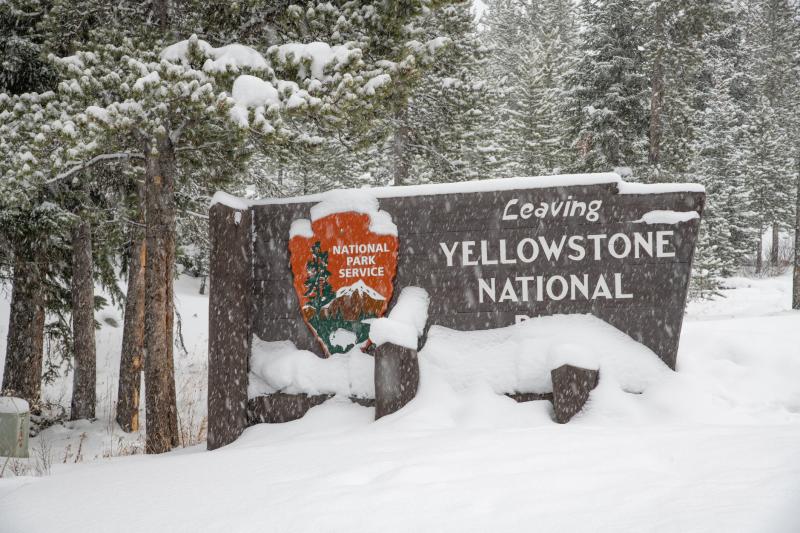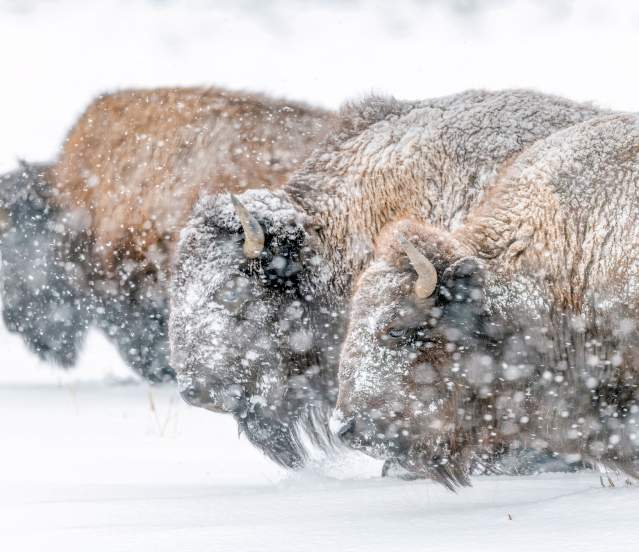As the world's first National Park, Yellowstone encompasses 3,471 square miles across Montana, Idaho, and Wyoming. While the park attracts millions of visitors annually, the majority arrive during the summer months. However, the winter season unveils a distinct and captivating side of Yellowstone…
Steaming geysers, frost-covered bison, limited services, and an utter lack of crowds make winter the prime time to visit the Park. While the majority of roads close in the park during the winter months, the road from the North entrance near Mammoth Hot Springs to the Northeast entrance remains open to vehicle traffic. The West entrance allows over-snow traffic to access a truly magical YNP experience.
Here are some of the most compelling experiences awaiting you in this snowy paradise:
Wildlife Viewing
One of the biggest reasons visitors flock to Yellowstone is in hopes of catching one-of-a-kind wildlife sightings, and the winter season is no different. Animals become more visible against a white canvas, and visitors may likely see bison, foxes, elk, moose, and even wolves.
Cross-Country Skiing
What could be more memorable than learning how to cross-country ski within the Yellowstone landscape? Take in more than learning a new sport as you glide into the quiet backcountry to view hidden geothermal gems and frozen waterfalls.
Snowshoeing
Another perfect opportunity to go off the beaten path and immerse yourself in Yellowstone's winter. Guided snowshoe tours offer a unique experience to explore the park with more freedom and flexibility.
Snowcoach Tours
Experience Yellowstone's magic from the warmth and comfort of a snowcoach. Perfect for families and groups, snowcoaches are very similar to a van or bus but with snow tracks instead of wheels. These excursions leave from West Yellowstone, MT and travel to places that are closed to vehicle traffic from mid-December through March, weather permitting.
Snowmobile Tours
Explore Yellowstone National Park with a guided snowmobile tour, an exhilarating full-day adventure. These tours typically include stops at iconic sites such as Old Faithful and the Grand Canyon of Yellowstone. Many outfitters provide full-body suits, boots, gloves, and helmets for an additional fee, ensuring you're well-equipped for the journey.
Winter Photography
Winter in Yellowstone is a photographer's dream, offering stunning landscapes and wildlife encounters. The snow and frost create dramatic scenes, while the park's magnificent wildlife becomes more visible against the pristine backdrop.
Visit the Northern Range
The Northern Range of YNP is accessible to personal vehicles year-round. Although a bit of a drive from Big Sky, accessing Yellowstone from the North entrance in the winter is a spectacular time to enjoy some of the most popular parts of the park such as Mammoth Hot Springs and Lamar Valley without all of the crowds that usually travel during the summer.
Geothermals
Against a snowy backdrop, the colorful hot springs and geyser basins throughout the park really show off their vibrancy, making it an ideal time to learn about these natural wonders. Booking a guided tour is a great way to enjoy an educational experience in Yellowstone.
Lodging and Learning
If you truly want to immerse yourself in all things Yellowstone, some groups offer learning and lodging packages where guests get to stay in the park while spending the day fully engaged in educational experiences in the field. These packages are led by exceptional naturalists who are experts in their field.

Know Before You Go:
- It's important to remember that winter travel in Montana does require some preparedness. If driving your personal vehicle into the North entrance, anticipate icy and snowy conditions.
- Ensure you have packed extra layers and gear such as gloves, hats, and boots for the cold winter conditions.
- Be prepared for limited services in the Park during the winter months, and conveniences such as cell service and connectivity are sparse within park boundaries.
- As always, do not approach wildlife and stay on boardwalks even when icy and snow-covered.
For further information and details about planning your trip to Yellowstone, visit our page: Yellowstone National Park.


